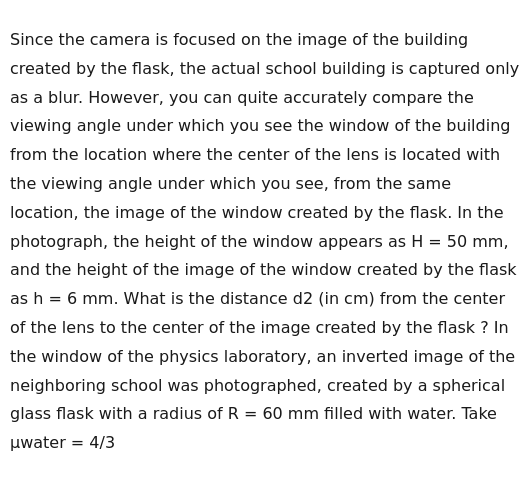Question
Question: Since the camera is focused on the image of the building created by the flask, the actual school bui...
Since the camera is focused on the image of the building created by the flask, the actual school building is captured only as a blur. However, you can quite accurately compare the viewing angle under which you see the window of the building from the location where the center of the lens is located with the viewing angle under which you see, from the same location, the image of the window created by the flask. In the photograph, the height of the window appears as H = 50 mm, and the height of the image of the window created by the flask as h = 6 mm. What is the distance d2 (in cm) from the center of the lens to the center of the image created by the flask ? In the window of the physics laboratory, an inverted image of the neighboring school was photographed, created by a spherical glass flask with a radius of R = 60 mm filled with water. Take µwater = 4/3

100
Solution
Here's how to solve this problem:
- Understanding the Setup:
- A flask filled with water acts as a lens, creating an inverted image of a school building's window.
- A camera is focused on this image.
- We're given the height of the window in the photo (blurred, H = 50 mm) and the height of the flask's image in the photo (sharp, h = 6 mm).
- The flask has a radius R = 60 mm, and the water has a refractive index µ = 4/3.
- Key Concepts:
- Viewing Angle: The angle at which an object is seen from a certain point.
- Angular Magnification: The ratio of the angle subtended by the image to the angle subtended by the object.
- Lens Formula (for a single spherical surface): vμ2−uμ1=Rμ2−μ1
- Focal Length of a Sphere (in air): 1/f=μR2(μ−1)
- Calculations:
-
Focal Length of the Flask:
- Using the formula for a sphere: 1/f=(34)(60)2(34−1)=1201
- So, the focal length f=120 mm.
-
Image Distance:
- Since the school building is far away, we can assume the object distance (u) for the flask is approximately infinity.
- Therefore, the image formed by the flask is at the focal point, so v=f=120 mm.
-
Angular Magnification:
- The problem states that the ratio of the heights in the photograph corresponds to the ratio of viewing angles: H/h=θH/θh. This means the angular magnification γ=θh/θH=h/H=6/50=3/25.
-
Relating Angular Magnification to Distances:
- For a distant object, the angular magnification is approximately γ=f/d2, where d2 is the distance from the camera lens to the image.
-
Solving for d2:
- 3/25=120/d2
- d2=120⋅(25/3)=1000 mm
-
Converting to cm:
- d2=1000 mm=100 cm
- Final Answer:
The distance d2 from the center of the lens to the center of the image created by the flask is 100 cm.
